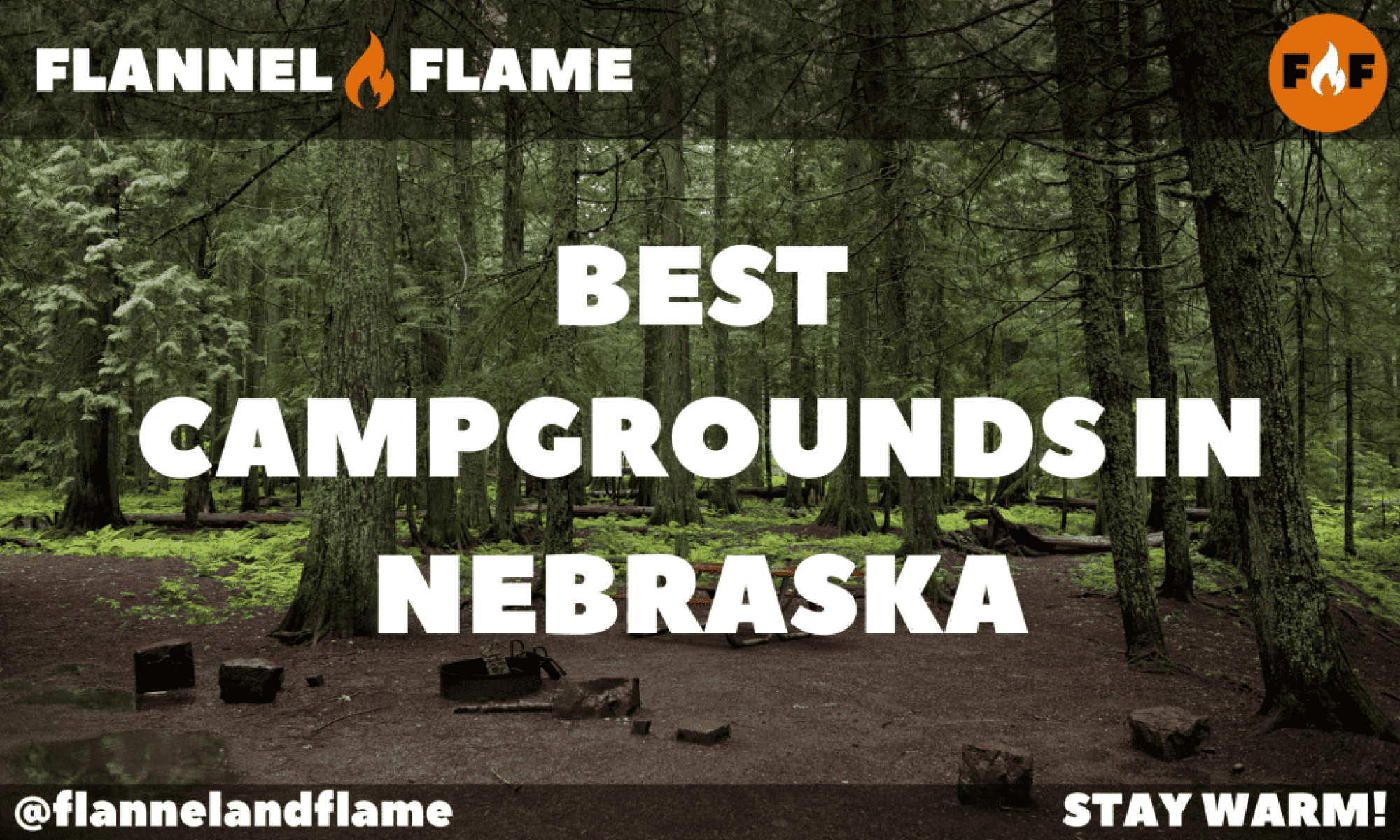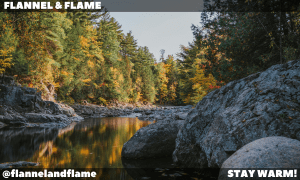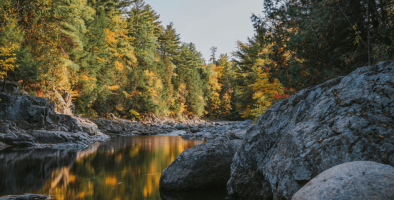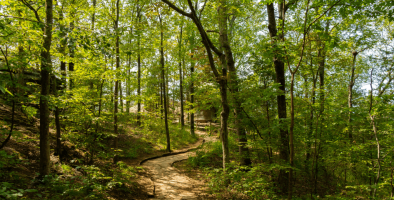Best Campgrounds in Nebraska
Nebraska might not be the first state that comes to mind when planning a camping adventure, but those who overlook this Midwestern gem are missing out on some truly spectacular outdoor experiences. From the rugged buttes and canyons of the western Panhandle to the rolling Sandhills that cover nearly a quarter of the state, from the forested river valleys to the vast reservoirs that punctuate the prairie, Nebraska offers surprisingly diverse landscapes for outdoor enthusiasts to explore. These top campgrounds showcase the natural beauty and tranquility that make Nebraska a hidden treasure for those who appreciate wide-open spaces and star-filled skies.
Lake McConaughy State Recreation Area
Number of Campsites: Over 100 designated sites, plus beach camping
Reservation Website: nebraskastateparks.reserveamerica.com
Address: 1475 Highway 61 N, Ogallala, NE 69153
Affectionately known as “Big Mac” by locals, Lake McConaughy is Nebraska’s largest reservoir – a 22-mile long oasis of crystal-clear blue water set against the backdrop of the state’s western plains. The white sandy beaches that line its northern shore have earned it the nickname “Nebraska’s ocean,” and camping here offers an experience that feels more like the coast than the Midwest.
The campground areas vary from developed sites with electrical hookups to primitive beach camping where you can park your vehicle right on the sand and fall asleep to the rhythmic sound of waves lapping at the shore. The beach camping is particularly magical, allowing you to step directly from your tent onto the soft white sand that stretches for miles along the lakeshore. The fine-grained sand, created from Ogallala Formation sandstone, feels wonderfully soft underfoot and glows almost blindingly white under the midday sun.
Mornings at Lake McConaughy often begin with mist hovering just above the water’s surface as the rising sun illuminates the eastern sky. The calls of western meadowlarks – Nebraska’s state bird – drift across the landscape, their flute-like songs carried on the gentle breeze that almost always seems to be present. The air carries the clean scent of water mixed with the subtle aroma of prairie grasses and wildflowers that grow where the beach meets higher ground.
The lake itself is the main attraction, with water sports of all kinds taking center stage during summer months. The clear blue waters invite swimming, while steady winds make this one of the Midwest’s premier sailing and windsurfing destinations. Anglers flock here for the exceptional fishing opportunities, with walleye, white bass, and trophy-sized rainbow trout among the potential catches.
As evening approaches, the setting sun casts a golden path across the water’s surface, and the western sky erupts in a spectacular show of oranges, pinks, and purples. Beach campers gather driftwood for small fires permitted on the sand, their flickering flames creating pools of warm light as darkness falls. With minimal light pollution, the night sky comes alive with stars spread across the vast dome overhead, occasionally accompanied by the distant calls of coyotes from the surrounding hills.
Toadstool Geological Park
Number of Campsites: 12
Reservation Website: First-come, first-served (no reservations)
Address: Toadstool Road, Crawford, NE 69339
For a camping experience that feels like sleeping on another planet, Toadstool Geological Park in Nebraska’s northwestern corner offers a landscape unlike anywhere else in the state. Named for the distinctive toadstool-shaped rock formations created through millennia of erosion, this remote park provides primitive camping in the midst of an other-worldly badlands landscape.
The small, rustic campground sits near the trailhead for exploring the park’s famous rock formations. Each site is simply a cleared area with a picnic table and fire ring, without hookups or modern amenities – but what the campground lacks in facilities, it more than makes up for in the surreal beauty of the surrounding terrain. The landscape feels ancient and eerily silent, with bizarre rock pillars rising from the eroded clay soil like sculptures created by a whimsical artist.
Mornings in the badlands bring extraordinary light, with the rising sun casting long shadows across the contoured landscape and illuminating the rock formations in shades of gold, pink, and amber. The air carries the distinctive mineral scent of the exposed clay soil, occasionally mixed with the sweet fragrance of prairie wildflowers that somehow find purchase in this harsh environment. Ravens often soar overhead, their glossy black forms contrasting sharply with the pale sky as they ride thermal currents rising from the warming earth.
Days here are best spent exploring the one-mile loop trail that winds through the heart of the formations, where you can walk among rocks eroded into shapes resembling mushrooms, chess pieces, and abstract sculptures. Fossils frequently erode out of the exposed layers, revealing remnants of ancient mammals that roamed this area millions of years ago when it was a lush savanna rather than the arid badlands of today. The park connects to the longer Hudson-Meng Bison Trail, which leads to an archaeological site where the bones of hundreds of extinct bison were discovered.
As evening approaches, the landscape is transformed yet again as the setting sun casts the rock formations in dramatic relief, their elongated shadows stretching across the gray-white soil. The absence of trees creates unobstructed views of the horizon in all directions, allowing you to watch the full progression of sunset painting the sky in vivid colors. After dark, the campground’s remote location – far from cities and towns – results in some of the darkest night skies in the Great Plains, with the Milky Way appearing as a bright ribbon across the heavens.
Fort Robinson State Park
Number of Campsites: 100+
Reservation Website: nebraskastateparks.reserveamerica.com
Address: 3200 US-20, Crawford, NE 69339
Where history and natural beauty combine, Fort Robinson State Park offers one of Nebraska’s most diverse camping experiences. Set against the dramatic backdrop of the Pine Ridge escarpment in the state’s northwestern corner, this former frontier military post has witnessed pivotal moments in Western history, including the tragic death of Crazy Horse and the last major engagement of the Indian Wars.
Today, the park offers multiple camping options, from RV sites with full hookups to tent camping areas nestled among ponderosa pines. The main campground sits near the historic buildings of the old fort, which now house museums and visitor facilities. The sound of hoofbeats might drift across the grounds as trail riders explore the park’s extensive equestrian trails, adding to the authentic Western atmosphere.
Mornings often begin with mist lingering in the valleys between pine-covered ridges, gradually burning off as the sun climbs higher. The air carries the distinctive scent of ponderosa pines – slightly sweet and vanilla-like, especially noticeable when the sun warms their bark. Meadowlarks and bluebirds provide a cheerful soundtrack, occasionally interrupted by the bugling of the park’s resident elk herd during fall months.
The landscape surrounding the campground offers incredible diversity, from the red rock buttes and canyons that punctuate the horizon to the grassy meadows where bison and longhorn cattle graze. Hiking trails lead to scenic overlooks where you can gaze across the vast expanse of the Great Plains stretching eastward, while to the west, the first foothills of the Rocky Mountains rise in the distance.
Recreation opportunities abound, with guided horseback rides, jeep tours to scenic overlooks, fishing in trout-filled streams, and even an outdoor swimming pool housed in a historic structure. History buffs will appreciate exploring the park’s museums and reconstructed buildings that tell the story of this important frontier outpost.
As evening approaches, the surrounding buttes are illuminated by the setting sun, their red rock faces glowing like embers against the darkening sky. From certain vantage points, you can watch as shadows slowly climb the face of prominent landmarks like Red Cloud Butte. After dark, the campground’s elevation and relatively remote location make for spectacular stargazing, with constellations appearing especially bright in the clear mountain air.
Merritt Reservoir State Recreation Area
Number of Campsites: 217
Reservation Website: nebraskastateparks.reserveamerica.com
Address: 26 Miles Southwest of Valentine on Highway 97, Valentine, NE 69201
Hidden in the heart of Nebraska’s Sandhills – the largest sand dune formation in the Western Hemisphere, now stabilized by prairie grasses – lies Merritt Reservoir, a pristine body of water surrounded by grass-covered dunes that roll to the horizon in every direction. This remote camping destination offers an experience of solitude and natural beauty that feels far removed from the modern world.
The recreation area features several campgrounds spread around the reservoir’s irregular shoreline, each with its own character. Cedar Bay and Main Area campgrounds offer electrical hookups and modern facilities, while Beeds Landing and Boardman Creek provide more primitive experiences for those seeking greater immersion in the natural environment. In all areas, the Sandhills provide a stunning backdrop – their gentle contours creating an almost hypnotic landscape that seems to flow like green waves across the horizon.
Mornings often begin with a light mist hovering over the reservoir’s surface, gradually dispersing as the sun rises over the eastern Sandhills. The calls of western grebes echo across the water, occasionally punctuated by the splash of a jumping fish. The air carries the sweet scent of prairie grasses mixed with the fresh aroma of the clear water – a combination that feels incredibly clean and invigorating.
During the day, the reservoir becomes a hub of activity for water enthusiasts. The consistently excellent fishing draws anglers seeking walleye, northern pike, and oversized bass. The lake’s irregular shoreline creates protected coves perfect for swimming, while the main body of water offers plenty of space for boating and water skiing. Nearby Snake River offers a completely different experience, with clear, spring-fed waters ideal for canoeing or tubing through the scenic canyons that cut through the Sandhills.
Perhaps most remarkable is the landscape surrounding the reservoir – the Sandhills themselves represent a unique ecosystem that covers nearly one-quarter of Nebraska. These grass-stabilized sand dunes harbor an incredible diversity of plant and animal life specially adapted to this environment. Evening drives along the park’s roads often yield sightings of mule deer, coyotes, sharp-tailed grouse, and occasionally even the elusive prairie chicken.
As night falls, the remoteness of this location becomes apparent in the most spectacular way possible. Merritt Reservoir is known for hosting the annual Nebraska Star Party precisely because it offers some of the darkest skies in the United States. On moonless nights, the Milky Way doesn’t just appear as a faint smudge but as a bright, detailed river of light spanning the entire sky, with thousands of stars visible to the naked eye.
Indian Cave State Park
Number of Campsites: 134
Reservation Website: nebraskastateparks.reserveamerica.com
Address: 65296 720 Road, Shubert, NE 68437
In the extreme southeastern corner of Nebraska, where the rolling hills meet the Missouri River, Indian Cave State Park offers a camping experience that feels more like the forested Ozarks than the Great Plains. Named for a large sandstone cave featuring prehistoric petroglyphs, this densely wooded park provides a welcome contrast to the state’s more open landscapes.
The campgrounds are spread across several areas, with both modern and primitive options available. Most sites nestle among mature oak, hickory, and walnut trees that create a dense canopy overhead, dappling the ground with patches of sunlight and shadow. In autumn, these same trees transform the park into a kaleidoscope of red, orange, and gold, making fall camping here particularly spectacular. The air carries the rich scent of decomposing leaves and fertile soil, occasionally mixed with the slightly muddy aroma of the nearby Missouri River.
Mornings in the park begin with sunlight filtering through the trees and a chorus of songbirds greeting the day – the melodious notes of wood thrushes, the cheerful chatter of chickadees, and the distinctive calls of whip-poor-wills that continue from the previous night. Deer often move silently through the campground in the early hours, browsing on understory vegetation with occasional glances toward human visitors.
The park’s extensive trail system offers excellent hiking through varied terrain, from ridge-top paths that provide glimpses of the broad Missouri River valley to cool, shaded ravines where delicate woodland wildflowers bloom in spring. The namesake cave, with its ancient petroglyphs carved by indigenous peoples centuries ago, connects visitors to the long human history of this region. For a unique experience, the park maintains a reconstructed 19th-century village that comes alive with demonstrations during special events.
Wildlife viewing opportunities abound, with white-tailed deer, wild turkeys, and a variety of songbirds commonly seen along trails. Lucky visitors might glimpse a fox, bobcat, or even the occasional river otter along the Missouri River shoreline. In spring and fall, the river serves as a major migration corridor, bringing bald eagles and numerous waterfowl species through the area.
As evening approaches, the dense forest creates an early twilight in the campground as shadows deepen among the trees. The sounds of the day gradually give way to a different chorus – the trilling of tree frogs, the distinctive calls of barred owls asking “who cooks for you,” and the chirping of crickets that seems to rise and fall in waves. Though the forest canopy obscures some of the night sky, clearings offer windows to the stars, and the more secluded areas of the park provide good stargazing opportunities.
Niobrara State Park
Number of Campsites: 104
Reservation Website: nebraskastateparks.reserveamerica.com
Address: 89261 522 Avenue, Niobrara, NE 68760
Perched on a bluff overlooking the confluence of the Niobrara and Missouri Rivers, Niobrara State Park offers some of the most dramatic vistas in Nebraska. This scenic park sits at an ecological crossroads, where four distinct ecosystems meet: eastern deciduous forest, northern boreal forest, western coniferous forest, and tallgrass prairie. This unique convergence creates a landscape of remarkable diversity and beauty.
The campground occupies an elevated position with many sites offering sweeping views of the river valleys below. Some areas feature mature trees that provide welcome shade, while others sit in more open terrain with panoramic vistas. The layout takes full advantage of the park’s topography, with campsites arranged along the contours of the land. The air carries mingled scents – the earthy aroma of the rivers, the sweet fragrance of prairie grasses, and occasionally the sharp scent of cedar from the nearby breaks.
Mornings often begin with fog filling the river valleys below while the campground sits above this sea of clouds, creating an almost otherworldly experience as the rising sun illuminates the mist from above. The calls of Swainson’s thrushes and rose-breasted grosbeaks filter through the trees, while in the distance, the distinctive croaking of great blue herons might drift up from their rookery along the Missouri.
The park offers excellent wildlife viewing opportunities, with white-tailed deer, wild turkeys, and a variety of songbirds commonly seen along trails. The rivers act as natural migration corridors, bringing bald eagles, pelicans, and numerous waterfowl through the area seasonally. For a unique perspective, the park offers guided pontoon boat tours on the Missouri River, allowing visitors to experience the mighty waterway up close while learning about its ecological and historical significance.
Hiking trails wind through the park’s diverse habitats, from shaded forest paths to open prairie walks with wildflower displays that change throughout the growing season. The views from the park’s higher elevations are spectacular, allowing visitors to gaze across the river valleys to the rolling hills beyond, with distant horizons that seem to stretch forever in true Great Plains fashion.
As evening approaches, the setting sun casts a golden glow across the landscape, with long shadows stretching across the prairie sections of the park. Watching sunset from the overlooks becomes a nightly ritual for many campers, as the western sky erupts in color while the rivers below reflect the changing light. After dark, the relatively remote location provides good stargazing opportunities, especially from the higher, more open areas of the park.
Ponca State Park
Number of Campsites: 100+
Reservation Website: nebraskastateparks.reserveamerica.com
Address: 88090 Spur 26 E, Ponca, NE 68770
Along the Missouri River in northeastern Nebraska, Ponca State Park offers a camping experience characterized by dramatic river bluffs, densely wooded ravines, and breathtaking views of the nation’s longest river. This park marks the beginning of the Missouri National Recreational River, a 59-mile stretch where the waterway flows freely as it did when Lewis and Clark passed through more than two centuries ago.
The campgrounds are spread across several areas, ranging from modern sites with electrical hookups to more primitive options for those seeking a rustic experience. Many sites nestle among mature oak, elm, and basswood trees that provide shade during summer months and spectacular color in autumn. The sound of wind moving through the tree canopy creates a constant, soothing background soundtrack. The air carries the rich scent of the deciduous forest – decomposing leaves, fertile soil, and the slightly silty aroma that rises from the nearby Missouri River.
Mornings in the park often begin with mist rising from the river valley as the first light illuminates the eastern sky. A chorus of songbirds greets the day – the flute-like notes of wood thrushes, the cheerful whistles of cardinals, and occasionally the distinctive calls of pileated woodpeckers echoing through the forest. White-tailed deer frequently browse at forest edges in these quiet early hours, moving with delicate care through the understory vegetation.
The park offers excellent recreational opportunities, with over 20 miles of hiking trails that wind through diverse habitats and lead to scenic overlooks with spectacular river views. The Missouri River itself provides fishing, kayaking, and canoeing opportunities, while the park offers educational programs about the river’s ecology and history. For a unique experience, visitors can rent electric-assist fat-tire bikes to explore the park’s more challenging terrain with less effort.
Wildlife viewing is exceptional, with the river corridor serving as a natural migration route that brings numerous bird species through the area seasonally. Bald eagles are common sights in winter, while summer brings orioles, tanagers, and a variety of warblers to the diverse forest habitats. Lucky visitors might spot river otters playing along the shoreline or catch glimpses of beavers working in the quieter backwaters.
As evening approaches, the forest grows quiet except for the occasional calls of barred owls beginning their nightly hunts. Campfires flicker throughout the grounds, their smoke carrying the sweet aroma of burning oak and hickory. From the river overlooks, visitors can watch as the setting sun casts a golden path across the water’s surface, with the distant bluffs on the South Dakota side silhouetted against the western sky.
Eugene T. Mahoney State Park
Number of Campsites: 149
Reservation Website: nebraskastateparks.reserveamerica.com
Address: 28500 W. Park Highway, Ashland, NE 68003
For families seeking a camping experience with abundant recreational opportunities, Eugene T. Mahoney State Park between Omaha and Lincoln offers the perfect combination of outdoor immersion and modern amenities. This popular park along the Platte River combines natural beauty with developed facilities to create a destination that appeals to campers of all experience levels.
The campground features well-maintained sites with electrical hookups, modern restrooms, and shower facilities. Most sites nestle among mature trees that provide welcome shade during Nebraska’s warm summers, while still allowing enough open sky for sunlight to filter through the canopy. The sound of wind moving through the oak and hickory leaves creates a pleasant natural soundtrack, occasionally mixed with happy sounds of families enjoying outdoor activities. The air carries the clean scent of the deciduous forest mixed with occasional wafts of campfire smoke – a combination that instantly evokes fond camping memories.
Mornings in the park begin with dappled sunlight creating shifting patterns on the forest floor as birds announce the new day – the clear whistles of cardinals, the melodious songs of brown thrashers, and the distinctive calls of red-bellied woodpeckers echo through the trees. Activity starts early, with joggers and cyclists taking advantage of the cooler morning temperatures to explore the park’s extensive trail system.
What sets Mahoney apart is the sheer variety of activities available without leaving the park. The family aquatic center provides welcome relief on hot summer days, while the indoor playground offers an alternative when weather doesn’t cooperate. An observation tower gives visitors panoramic views of the Platte River valley, especially spectacular during spring and fall migrations when thousands of sandhill cranes and waterfowl pass through. Other activities include fishing, paddleboating, miniature golf, and a treetop ropes course.
Nature enthusiasts will appreciate the park’s location within the Platte River valley, an internationally significant migration corridor. The river itself is shallow and braided, creating sandbars and channels that attract numerous bird species. Hiking trails lead through woodland habitats where white-tailed deer, wild turkeys, and a variety of songbirds can often be spotted, especially during quieter early morning hours.
As evening approaches, the park takes on a magical quality as fireflies rise from the forest floor, creating natural light displays among the trees. From certain vantage points, visitors can watch the sunset illuminate the Platte River, turning its surface to burnished gold before darkness falls completely. Despite being located between Nebraska’s two largest cities, the night sky still offers good stargazing, with the Milky Way visible on clear nights away from the park’s more developed areas.
Chadron State Park
Number of Campsites: 70
Reservation Website: nebraskastateparks.reserveamerica.com
Address: 15951 Highway 385, Chadron, NE 69337
Nebraska’s first state park continues to be one of its most beautiful. Nestled in the Pine Ridge escarpment of the state’s northwestern corner, Chadron State Park offers a camping experience that feels more like the Black Hills than the Great Plains. The park’s 972 acres encompass ponderosa pine forests, dramatic buttes, and open meadows – creating a diverse landscape that seems worlds away from the stereotypical image of Nebraska.
The campground sits among stately ponderosa pines that provide welcome shade and natural separation between sites. The forest floor is carpeted with pine needles that create a soft, aromatic surface underfoot and release their distinctive scent with each step. The air carries the vanilla-like fragrance of sun-warmed ponderosa bark mixed with the clean, slightly resinous aroma of the pine forest – a combination that feels refreshing and invigorating.
Mornings begin with sunlight filtering through the pine canopy and the cheerful chatter of mountain bluebirds and western tanagers. The quality of light here is remarkable – crystal clear in the thin mountain air, creating sharp contrasts between sunlit areas and cool shadows. Early risers might spot mule deer moving silently through the campground or wild turkeys strutting among the trees, their iridescent feathers catching the slanted morning light.
The park sits at an elevation of approximately 5,000 feet, creating a climate distinct from most of Nebraska, with cooler temperatures that provide relief during summer months. Hiking trails lead through diverse habitats, from pine-covered ridges to hidden canyons where springs create pockets of lush vegetation. For a more adventurous experience, the park connects to the Nebraska National Forest, where hundreds of miles of trails await exploration by foot, mountain bike, or horseback.
Wildlife viewing opportunities abound, with the chance to spot not just deer and turkeys but also pronghorn antelope in the more open areas, along with occasional elk that have wandered over from nearby Fort Robinson. Birdwatchers will appreciate the diversity of species, including western specialties not commonly seen in eastern Nebraska, such as pinyon jays, pygmy nuthatches, and various western warblers.
As evening approaches, the slanting light turns the ponderosa pines to gold and lengthens the shadows across the campground. The western horizon often puts on a spectacular show as the sun sets behind distant buttes, painting the sky in vivid oranges and purples. After dark, the higher elevation and distance from major cities create exceptional stargazing conditions, with the Milky Way appearing as a bright, detailed band stretching across the night sky.
Final Thoughts About Camping in Nebraska
From the pine-covered ridges of the northwest to the densely wooded river valleys of the southeast, from the rolling Sandhills at the state’s center to the expansive reservoirs that provide oases on the plains, Nebraska offers camping experiences to suit every outdoor enthusiast. What ties these diverse destinations together is the sense of space and tranquility that defines Great Plains camping – the big sky overhead, the distant horizons that seem to stretch forever, and the opportunity to experience nature away from crowds. Whether you’re seeking adventure, relaxation, or a deeper connection with the natural world, Nebraska’s best campgrounds provide the perfect base for discovering the underappreciated beauty of this remarkable state. Pack your tent, embrace the spirit of exploration, and discover why Nebraska deserves a prominent place on every camper’s bucket list.
Other States to Explore
More from Flannel & Flame…
- Mexican Bean SaladBold, zesty, and bursting with color, this Mexican Bean Salad is a side dish that brings the flavor anywhere you roam. A hearty mix of black, kidney, and cannellini beans comes together with crisp bell peppers, sweet corn, and red onion, all tossed in a citrusy vinaigrette loaded with fresh cilantro and just the right… Read more: Mexican Bean Salad
- Cheesy PotatoesGolden, gooey, and loaded with flavor, these Dutch Oven Cheesy Potatoes are a campfire favorite that never disappoints. Tender hash browns are layered with melted cheese, savory seasonings, and just the right amount of smoky goodness from the fire. Baked slow and steady in a Dutch oven, this comforting side dish is perfect alongside grilled… Read more: Cheesy Potatoes
- Alternatives to S’Mores: Sweet Twists and Campfire Treats You’ll CraveThere’s something undeniably magical about a gooey s’more melting between your fingers under a starlit sky. The way the chocolate gets just soft enough, the marshmallow smolders to a golden hue (or charred to a crisp, if that’s your thing), and the graham crackers give that perfect crunch — it’s the taste of summer, nostalgia,… Read more: Alternatives to S’Mores: Sweet Twists and Campfire Treats You’ll Crave
- Best Hiking in New YorkWilderness, waterfalls, and wonder from the Catskills to the Adirondacks New York might be synonymous with skyscrapers, yellow cabs, and a certain iconic skyline—but trust me, beyond the hustle of the city, the Empire State hides some of the most jaw-dropping trails in the Northeast. We’re talking misty mountaintops, mossy forests, gorges carved by ancient… Read more: Best Hiking in New York








